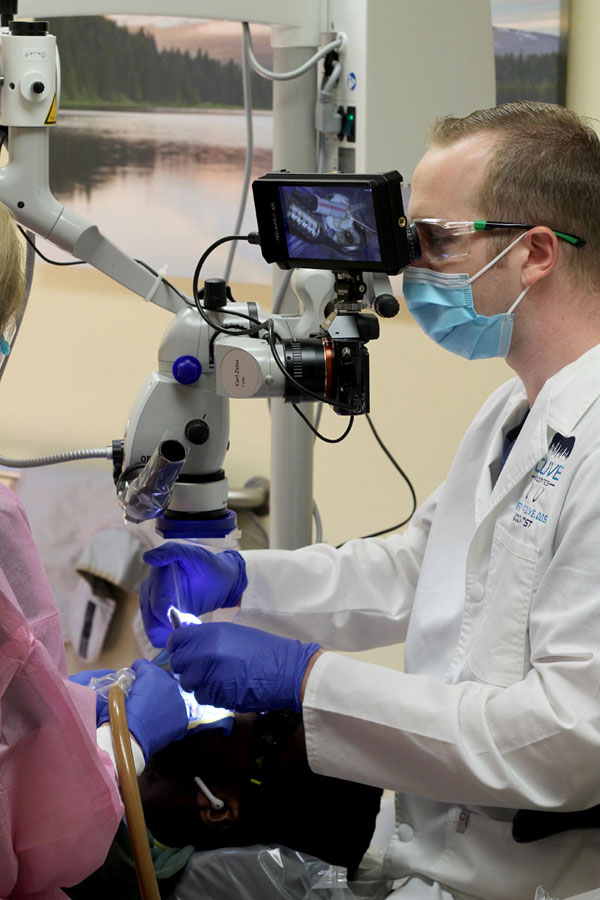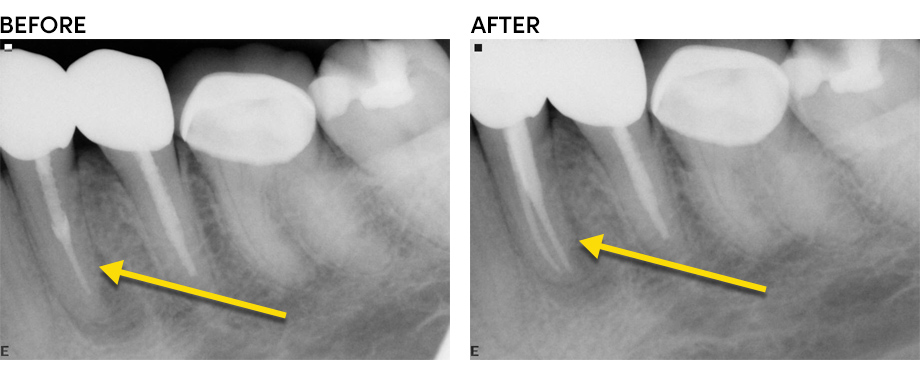What is a root canal?
Every tooth has a system of canals. These canals are filled with nerve tissue. Due to decay, deep restorations, fractures or trauma, the nerve tissue becomes inflamed and may die. Bacteria can invade this space and cause infections in the surrounding bone and soft tissue. We can diagnose infections on radiographs as the bone is lost around the ends (or apex) of the roots. After a tooth is diagnosed with a root canal problem, root canal treatment may be needed.
Root canal treatment involves using small instruments to clean out the nerve tissue and/or bacteria in the canals and enlarge them. The canals are filled with a non-metallic, rubber-like material (gutta percha) to seal the canals and prevent contamination. A temporary or permanent filling is then placed depending upon what your general dentist has requested.
What is the process like?

The first step is to test the tooth to arrive at a diagnosis. This will involve taking a radiograph (X-ray), tapping on teeth, testing them to cold, measuring the gums, and occasionally other tests as needed. If a diagnosis determines that a root canal is needed, we will get you a treatment plan and an estimate of the associated fees. We will numb your tooth using local dental anesthesia. We will place a rubber sheet (dental dam) around your tooth, to protect the canals from bacteria in your saliva. After the rubber dam is placed, your doctor will make a small hole in the tooth to get to the nerve space (pulp chamber) and will start cleaning out the chamber and canals using small instruments and rinses that disinfect the canal spaces. After the canals have been cleaned out thoroughly, root canal filling materials are placed in the canals and sealed in place. An x-ray may be taken during the cleaning or try-in phase of treatment. After the root canal is complete, a temporary or permanent filling is placed in your tooth and a final X-ray is taken that will be sent to your dentist. You may be asked to see your dentist in a week or two to have a permanent filling placed if we placed a temporary filling.
Why is a microscope used?
Dental operating microscopes enable your doctor to look at your tooth magnified so that your treatment can be as predictable as possible. Magnification can be adjusted during your treatment from 4x-25x.
 With the aid of a microscope, small canals can be located, cracks can be diagnosed, and we can be sure that all the decay or defective restorations are removed. This image shows what you can see with the naked eye, dental loupes (dental magnifiers on glasses), and the microscope can see. Notice how much more you can make out the crack with the microscope!
With the aid of a microscope, small canals can be located, cracks can be diagnosed, and we can be sure that all the decay or defective restorations are removed. This image shows what you can see with the naked eye, dental loupes (dental magnifiers on glasses), and the microscope can see. Notice how much more you can make out the crack with the microscope!
What is the success rate of root canals?
The success rate depends on if the tooth is already abscessed. Healing rates of 95% can be expected if the tooth is treated before developing an abscess, and 80-85% after an abscess has formed. Other factors can also affect success rates such as the presence of bone loss from gum disease, complex root canal anatomy, draining infections, fractures, if proper restorative work is done following the procedure, and health related factors, like diabetes.
Will I need to come back to see if the root canal is healing?
In cases where the tooth’s prognosis is not favorable, we may ask you to return in 6-12 months for a follow up radiograph (x-ray) to check the healing of your tooth. This is done at no charge.
Are root canal treatments painful?
We are dedicated to treating your tooth the most painless way possible. You will be able to feel the in and out motions of the procedure but should not feel pain. If you feel pain, please let the doctor know and more anesthetic can be used to numb your tooth. Teeth having root canals may require more anesthesia than normal because the nerve is especially sensitive or inflamed.
Are root canals safe?
Information you may find on the internet claiming that if you receive a root canal treatment you’re more likely to become ill or contract a disease in the future simply isn’t true. This false claim was based on long-debunked and poorly designed research conducted nearly a century ago, long before modern medicine understood the causes of many diseases. There is no valid, scientific evidence linking root canal treatment to disease elsewhere in the body.
25 million endodontic treatments are performed every year, safely and effectively. If it were true that root canals caused diseases like cancer, there would be much more information about it available in peer-reviewed scientific publications, and root canals would not be the preferred treatment option to save teeth.
To learn more, please view the AAE Statement on Root Canal Safety.
What are signs that I need a root canal?
If your tooth is irreversibly inflamed or infected, it may need a root canal. Signs of these conditions include spontaneous pain, which may wake you up at night, lingering cold sensitivity, hot sensitivity, pain to biting, facial swelling, gum swelling, draining through a pimple in the gums, and bone loss around your tooth that is detected by your dentist on an x-ray.
Will I need antibiotics? Or pain pills?
Typically, you will not need to be on antibiotics after treatment unless there are signs of systemic involvement or aggressive infection. In patients with joint replacement or heart conditions, you may need to take a single dose of antibiotics before your appointment. Please check with your orthopedic surgeon or cardiologist prior to your appointment to get the necessary prescription.
Following treatment, we recommend non-steroidal pain medication, like ibuprofen (Motrin®, Advil®) and Tylenol® instead of narcotics. We will let you know about your recommended dosage at your appointment.
What can I expect after treatment? When will my tooth feel better?
After a procedure, the numbing may last for 2-8 hours. After the anesthetic wears off, it is normal to experience mild to moderate soreness for the first few days up to 2 weeks after the procedure. To help manage this, we typically recommend over-the-counter pain medication, like ibuprofen and Tylenol®. However, if there was cold sensitivity, that should go away completely after the anesthetic wears off. If you are experiencing severe pain after treatment, or if moderate pain persists beyond 2 weeks, we recommend you come back to see us to check that everything is healing.
What are the risks of root canal treatment?
Every treatment has risks and root canals are no exception. We cannot guarantee that every case will heal, especially when the prognosis is guarded or questionable. Treatment risks include non-healing, separation of files within the tooth (3%), drilling outside the tooth when looking for canals, leakage of antibacterial rinse under the rubber dam or through the tooth into the bone (rare), persistent bacteria, and weakening of the tooth structure such that the tooth fractures (This is why crowns are frequently recommended in premolar and molar teeth after root canals). Many times, complications can be managed effectively and do not significantly affect the prognosis.
What is a retreatment?
 Retreatment is a “redo” or a revision of a previous root canal. It is necessary when there is leakage of saliva into an existing root canal or when all of the canals were not located and treated. The old, contaminated root filling material is removed, the canals cleaned, disinfected, and new root filling material is placed. These x-rays show a premolar tooth that had a retreatment. You can see how a second canal was found and cleaned out that should enable the tooth to heal.
Retreatment is a “redo” or a revision of a previous root canal. It is necessary when there is leakage of saliva into an existing root canal or when all of the canals were not located and treated. The old, contaminated root filling material is removed, the canals cleaned, disinfected, and new root filling material is placed. These x-rays show a premolar tooth that had a retreatment. You can see how a second canal was found and cleaned out that should enable the tooth to heal.
What is an apicoectomy (apico) or endodontic surgery?
Root canal therapy is a highly successful procedure. However, sometimes teeth fail to heal. In these cases, retreatment or root end surgery may be required. While retreatment is recommended in the majority of cases, a surgical approach, called an apicoectomy, may be the better treatment in certain situations. During this procedure, the end of the root is surgically exposed by lifting the gums away from the side of the tooth, a few millimeters of the root end are removed, then a filling is placed in the root end to seal the canal, and the gums are sutured closed. An apicoectomy may be the only way to save a tooth that would otherwise be extracted.
We also perform root amputations (where one troubled root is removed) and intentional replantation (where the entire tooth is removed, treated outside the mouth, and then replaced inside the socket).
Endodontic surgery can lead to swelling of the tissues during the first few days after the procedure. We often prescribe an antibacterial mouth rinse along with a pain medication and antibiotics when necessary.
Will my tooth need a crown (cap) after my root canal?
Crowns are placed on teeth after the root canal to ensure protection against fracture. Most molar and premolar teeth will need a crown after a root canal. But your regular dentist is the person who will provide this service. Sometimes a crown may not be necessary, please contact your general dentist to discuss your needs.
I have a crown on my tooth. Will I need a new one?
Most of the time, it is possible to drill a small hole through the crown which can easily be restored. There is always a possibility, however, that the integrity of the crown may be compromised, requiring a new crown.
Why was I told this may take two appointments?
At the first appointment, the interior of the tooth is cleaned and disinfected. If the amount of infection or inflammation is too severe, a second appointment will be required. However, most root canal treatment can be completed in one appointment. We want you to have lasting results. Rushing to finish a root canal before it is ready can lead to imperfect results that risk early failure of the treatment.
Why do I have to pay a deposit if I have insurance?
Insurance coverage varies from plan to plan, but most do not cover 100% of treatment costs. We estimate what each patient’s portion of the fee will be, collect that fee at the time or service, and file a claim to the insurance company. If the insurance company pays more than we estimated, we will send a refund check during the next month. If the insurance company pays less than our estimated amount, we will send an invoice for the remaining balance. Our estimates are usually very close.
Why can’t my general dentist perform this procedure?
General dentists are licensed to perform root canals, but a root canal is a delicate procedure with complicating factors. Some root canal treatments, especially retreatment or endodontic surgery, are difficult for even the best dentist. Your dentist shows they care about you by referring you to an expert who can deliver top notch care even in cases of high difficulty. With our expertise and technology, we can treat teeth to a specialist level. When performed by an endodontist, difficult cases tend to take less time and have more predictable outcomes.
FOR PATIENTS:
About Endodontics

